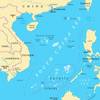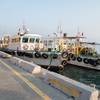Ballast water was first recognized by the scientific community as a vector for transfer of potentially invasive marine species more than 30 years ago. It took a number of years, and acceptance that zebra mussels had reached the Great Lakes in the ballast water of ships arriving from the Black Sea, before the maritime industry generally acknowledged that they were part of the problem. Initially, high seas ballast water exchange was the only available means for removing potentially invasive species from the tanks. That methodology presented risks to the stability of the ship (and the safety of the crew), as illustrated by the near-loss of the car carrier Cougar Ace in 2006 in waters of the North Pacific Ocean just south of the Aleutian Chain.
The search for alternative means of reducing the risk of introduction of invasive marine species commenced immediately, but problems quickly arose. Environmental advocates could not agree amongst themselves as to how low the risk should be and what methodologies should be acceptable. Some environmentalists contended that the ballast water should be sterilized before discharge, making it much more pure than common tap water. Some in the marine industry tried to deny that a problem existed or that, if it did, existing vessels should not have to be altered. Some nations (and in the United States, some states, and one city) adopted independent standards, resulting in a patchwork of requirements that continue to vex the marine industry.
Finally, on February 13, 2004, Party States approved the International Convention for the Control and Management of Ships’ Ballast Water and Sediments, 2004 (BWM Convention). There is a big difference, though, between getting attendees at an international conference to sign a document as they head out the door and getting the governments that sent them to formally ratify and agree to be bound by a new convention. This has been particularly true with the BWM Convention, where many of the provisions were aspirational in that technology for achieving the goals of the Convention did not exist in 2004. The BWM Convention did, though, establish standards for measuring the acceptability of ballast water control devices. As a result, engineers now had a clear goal and began the process of designing and testing various technologies for meeting those control standards. It took several more years, but technologies were finally shown as meeting the BWM Convention standard. Now, there is a critical mass of approved technologies, providing ship owners an opportunity to select the system that works best in their particular situation. As of August 9, 2011, 34 ballast water management systems that make use of active substances have received basic approval under the BWM Convention approval process and 20 such systems have received final approval.
There is a fly in the ointment of the BWM Convention. Seven years after its promulgation, the Convention is still not officially in force. The Convention provides that it will come into force 12 months after the date on which not less than 30 states, the combined merchant fleets of which constitute not less than 35% of the gross tonnage of the world’s merchant shipping, have ratified or otherwise accepted the Convention. As of November 30, 2011, the BWM Convention has been ratified by 31 states with 26.44% of the required gross tonnage. There are strong indications, though, that the threshold for implementation will be met during 2012, such that the Convention can officially come into force during 2013. Based on this expectation, ship owners increasingly are installing approved ballast water management systems in their existing vessels and new vessels are being designed to include those systems.
In the meantime, the US Coast Guard worked to develop a standard for vessels operating in US waters. The political will necessary for the United States to ratify the BWM Convention was lacking. After much consensus building, the Coast Guard finally proposed a domestic standard consistent with the international standard, with the proviso that the domestic standard would be tightened when it was shown that technology had improved to a significantly higher level. As of the writing of this article, the Coast Guard final rule is undergoing review at the Office of Management and Budget (OMB) with publication in the Federal Register expected for early 2012.
After a federal court ordered the Environmental Protection Agency (EPA) to regulate ballast water discharges through its National Pollutant Discharge Elimination System (NPDES), some commentators lost hope that the federal government could develop an internally unified standard. After much consideration, though, the EPA recently proposed that, commencing in 2013, covered vessels implement as part of the Vessel General Permit (VGP) program the same standard as that proposed by the Coast Guard.
Things are not quite as smooth at the state level. The good news is that Wisconsin recently changed its position and will only enforce the standard found in the BWM Convention. California continues to cling to its very high standard, despite evidence that that is no technology in existence that can achieve the required level of purity. California, though, has extended its deadline in the past and is expected to do so in the future unless and until a technological breakthrough is achieved. New York State is now the lightning rod on the ballast water management issue. It conditioned the state’s approval of the EPA VGP program on the inclusion of a ballast water discharge standard for New York waters similar to that of California but with a harder deadline. New York has grudgingly granted one brief extension of deadline, but will provide no signal that further deadlines should be anticipated. Meanwhile, despite all the evidence to the contrary, it contends that there is technology available to meet its very high ballast water discharge standard.
Some members of Congress have finally decided to address the issue directly. The Coast Guard and Maritime Transportation Act of 2011 (H.R. 2838) as approved by the House of Representatives on November 15, 2011, includes a provision that would limit the ability of the individual states to impose more stringent ballast water discharge standards on commercial vessels than those imposed by the federal government. The bill is now under consideration by the Senate.
It is possible, albeit unlikely, than none of the potential breakthroughs discussed above will come to fruition in 2012. It is more likely that the BWM Convention will acquire that requisite ratifications to allow it to come into force; that the US Coast Guard will promulgate its ballast water management regulation mirroring, in large part, the BWM Convention standards; and that the EPA will publish its 2013 VGP program standards following the Coast Guard lead with respect to ballast water management. The fate of the Coast Guard and Maritime Transportation Act is less certain. The coming year will see a highly contentious national election campaign, which may provoke legislative gridlock on Capitol Hill. Developments at the state level are even less predictable.
Over all, though, 2012 may be the year in which stars align for ballast water management and things finally get beyond top dead center. These developments will result in even more vessels installing modern ballast water treatment equipment and will encourage manufacturers to develop improved ballast water management technology.
(As published in the January 2012 edition of Maritime Reporter & Engineering News - www.marinelink.com)















